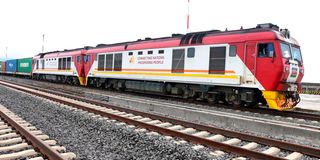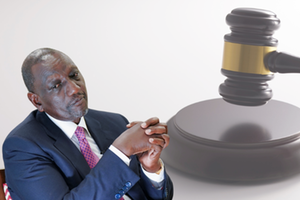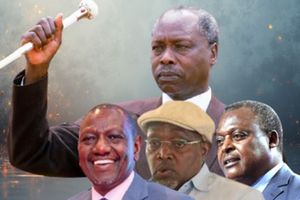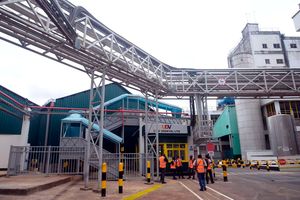Premium
When power projects generate more darkness than light

Lake Turkana Wind Power project in Laisamis, Marsabit County.
Once upon a time, the Kenya Power supremo Samuel Gichuru and Finance minister Chris Okemo hid $4.9m in an offshore account. The money came from Kenya Power projects, real and imagined.
Today, both men are still walking in Nairobi, and the Director of Public Prosecutions held their extradition in abeyance since Gichuru was “sick.” The Energy sector is the space where impunity thrives – and it is no longer surprising but sickening. Gichuru was so powerful that no media touched him. He walked through the corridors of power with the might of a penstock!
Last week, a conman called me threatening to cut my power, and I told him to uproot the pole and the wiring! It is much easier to catch and jail such a petty conman – but it is extremely hard for Kenya to jail those involved in energy sector crimes. As I said before, the entire power sector is a crime scene. Power projects generate more darkness than light.
This week, our attention has been shifted to the Lake Turkana Wind Power Project – the giant energy ogre of our times said to have been paid Sh18 billion under the ‘take or pay’ clause that was initially flagged by the auditor-general, Nancy Gathungu, in her report to parliament. From these idle power charges, parliament was later told there was an extra Sh785 million wired by Kenya Power, which was rejected by a German bank, citing a lack of sufficient details of the final beneficiary.
But this is not only about Lake Turkana Wind Power but also about our collective responsibility as a nation to question all these deals that smell like development projects and to prosecute those fingered out by the Ethics and Anti-Corruption Commission.
When it started, we were told that the wind power project was part of our collective Vision 2030, that smokescreen created by cartels and State Capture barons to stop us from questioning the dirty dealings done in the name of a shared vision. With it came the Standard Gauge Railway, where we sank $3.9 billion (Sh585 billion) from Mombasa to Suswa, the moribund $478.9 million Lamu Port, the projected Sh595.8 billion Konza City — supposed to be complete by 2030 — and the Jomo Kenyatta International’s Greenfield Terminal where a Chinese firm has been demanding Sh22 billion for termination of its contract. These are some of the debts we are repaying, including the unaccounted-for $2 billion Eurobond set to be paid in 2024. We have not even looked at the stalled dams, Mumias, and laptops project.
When you look deep inside these Vision 2030 projects, you understand the meaning of ‘budgeted corruption” – as former auditor-general Dr Edward Ouko used to call those infrastructure projects that left the country with billions of debts as we cheered on our politicians during the launch.
In the next seven years, as part of this collective dream, we were supposed to be “a newly-industrialising, middle income country” that provides “a high quality of life to all its citizens in a clean and secure environment.” Sadly, we won’t as we are mobilised to share a joint Vision 2030 (or the latest fad Bottom-Up Economic Transformation Agenda — BETA) and other vocabularies on progress. During that state of political delirium, fancy projects are legally devised during political; the wananchi are mobilised to share the dream, parliamentary approval is received, and cartels are identified to share the loot. That is state capture at its best and has been with us since Harambee mobilisation of the 1960s and 1970s.
When it was conceptualised, the Lake Turkana Wind Power project was considered part of our collective dream. But behind it was much politics, interests, and backstabbing. But since it was part of “our” Vision 2030 on cheap energy, we never raised any word. Thus, the Ministry of Energy, Kenya Power, and the Kenya Electricity Transmission Company (Ketraco) engaged Lake Turkana Wind Power Limited for us. This project was a “public-private partnership” and was not subject to any competitive bidding. Again, all the big financiers, including the World Bank (which later walked away) and the East African Development Bank, had lined up. Since we kept quiet, silence was deemed to be consent. That is why we are not victims but accomplices in the expensive power racket coordinated for us by Kenya Power and the associated politicos.
Lake Turkana Wind Power was not the first Independent Power Producer to make such a proposal for the Turkana basin. Another company, Gitson Energy (later shoved aside), had in 2003 approached Kenya Electricity Generating Company (KenGen) inquiring whether it would be willing to cooperate in the exploration and exploitation of potential wind energy. KenGen agreed on January 7, 2005, and the Ministry of Energy confirmed, through Permanent Secretary Patrick Nyoike, that the power generated would be purchased by Kenya Power on agreed terms. Gitson carried out the feasibility studies and established the viability of the project. Still, in 2005, Lake Turkana Wind Power Ltd contracted, DEWI an international energy firm, to carry out wind tests, and the proposal was sent to the government in April 2006. But it was the Lake Turkana Wind Power whose contract got instant approval. Reason: your guess is as good as mine. The Kenya Power Board approved Lake Turkana Wind’s proposal on November 4, 2009. By December 11, 2009, all the pending approvals were done.

An SGR train at the Naivasha Inland Container Depot on January 17, 2022. The government’s plan to electrify the standard gauge railway (SGR), as proposed by the World Bank, is timely and the relevant agencies ought to commence its implementation.
To cut the story short, Lake Turkana Wind Power would later stand on the land that Gitson wanted.
That story reminds me that Jimi Wanjigi’s company had carried out feasibility studies for the Standard Gauge Railway before it was snatched from him by the Uhuruto regime, and it became an expensive Government-to-Government project. Wanjigi says that his project would have cost a fraction of what we used, and the money he had negotiated, without committing the taxpayer, would have built a Standard Gauge Railway to Kisumu with stations and a road!
Kenyans continue to pay for expensive energy because of what on paper, seems like mistakes. Under clauses 10.9 and 14.6c of the Power Purchase Agreement, the government agreed to provide a sovereign guarantee to Lake Turkana Wind Power for a commercial default if Kenya Power reneged on payments. In 2010, the government cancelled the Sovereign clause and, according to a Parliamentary Investment Committee report, it “attempted to structure an alternative security package with the World Bank…This alternate also comprised a letter of credit guaranteed by the International Development Association to cover the payment default.” The consumer was to meet this extra cost, and the energy charge rate was reviewed upwards – meaning we would purchase expensive energy due to increased total costs.
There was a financial arrangement (call it a loan) between Kenya and the Kingdom of Spain in which we were to get money to build the transmission lines. This contract was signed in October 2009, and the condition was that the contract should be awarded to a Spanish contractor. And so, a “steering committee” that had officials from Kenya Power and KETRACO – with the assistance of Lake Turkana Wind Power – went shopping for a Spanish firm, and that is how Isolux was brought on board. All this was done under the banner of Vision 2030.
The other problem was that the Spanish contract was signed before Wayleaves’ acquisition. Due to the delays, the Kenyan taxpayer was slapped with a penalty of Sh18 billion since the power project was completed before the transmission lines. It meant that under the Power Purchase Agreement, there were 19 months between January 2017 and September 2018 when we paid for power we never used. The main contractor, Isolux, then filed for bankruptcy, meaning Treasury had not carried out due diligence.
On January 10, 2018, the Treasury approved a Consortium of NARI Group and Power China Guizhou Engineering to complete the Loiyangalani-Suswa line for Sh11 billion. There are many stories on Ketraco and its millionaires.
In the Vision 2030 hurry, due process was never followed. A Court in Meru would later find the land on which the project stood was acquired irregularly. It ordered the nullification of the title deeds, arguing that the Constitution was not followed when Lake Turkana Wind Power Ltd was allocated 150,000 acres of community land.
In the scheme of things, Vivienne Yeda Apopo, the Director General of the East African Development Bank (EADB), which co-financed the €623 million project, was appointed chair of Kenya Power in November 2020. We can only say this was a curious appointment since EADB had interests in the energy sector. Again, the less said, the better. Suffice it to say that when William Ruto came to power, Ms Apopo was removed. Kakamega Governor Fernandes Barasa, the former Ketraco CEO, was recommended for prosecution. What can I say: In the power sector, the more things change, the more they remain the same.
[email protected] @johnkamau1




